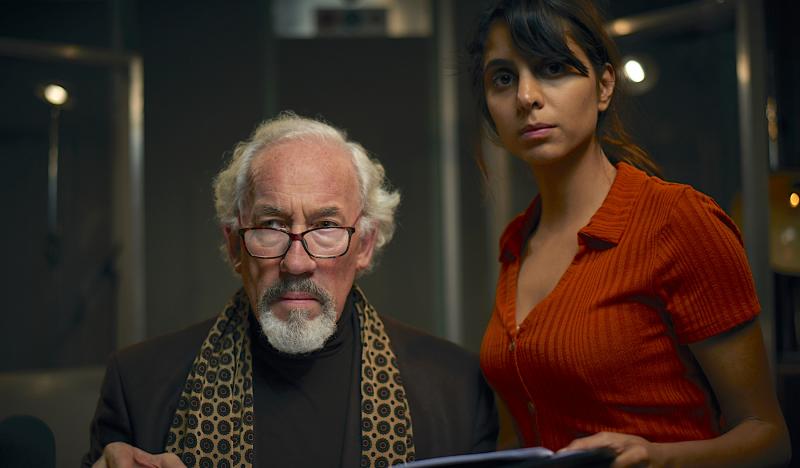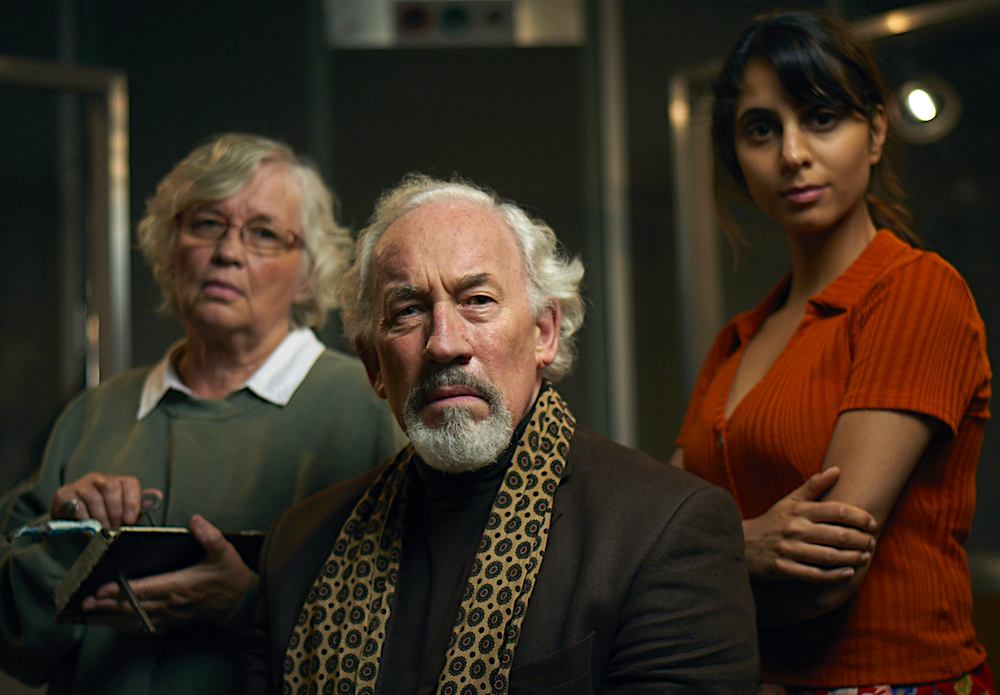The Dead Room, BBC Four review - ghosts at the microphone | reviews, news & interviews
The Dead Room, BBC Four review - ghosts at the microphone
The Dead Room, BBC Four review - ghosts at the microphone
Simon Callow shines in Mark Gatiss's supernatural tale

Fired by the spirit of the MR James ghost stories which used to be a Christmas staple on the BBC, Mark Gatiss conceived this amusing bonne bouche as both a seasonal chiller and a nod to the ghost of broadcasting past.
His vehicle for this was the venerable thespian Aubrey Judd, host of the long-running radio show The Dead Room when he's not picking up TV bit-parts as "dementia man 2". As he described it himself, in his fulsome and fruity and r-rolling baritone, “Aubrey Judd, bringing mild disquiet to radio listeners since 1976”. No-one could have done this better than Simon Callow, who took to the role with all-consuming gusto, bringing to mind generations of old-school actors who have struggled to readjust to changing times and galloping technology. "There's no privacy any more, not a scrap," he wailed, in a rant about the iniquities of social media.
Pompous and self-obsessed, inclined to deliver didactic speeches about how things were done in the old days (and why they were better), Judd was an index of incorrectness. The mutual incomprehension between himself and his young producer Tara (he kept calling her Tanya) was neatly portrayed, as Judd rudely dismissed her choice of a new writer’s story about “teens playing haunted computer games” as a piece of nonsense which gave no respect to the classic rules of horror stories. He tartly corrected her use of the phrase “quite unique” – “it’s either unique or it’s not.” Tara (Anjii Mohindra) felt forced to enlighten him that his use of the terms “knockers” and “dwarf” were no longer acceptable (pictured below, Mohindra and Callow with Susan Penhaligon as Joan). Nonetheless, Judd’s doomy Victorian-gothic delivery of his scripts was a treat to behold, while the depiction of the workings of a radio studio was handled with documentary-style verité. Gatiss worked another ingenious angle by setting his story in the BBC’s old Maida Vale studios, a slice of Corporation history now scheduled for closure. This was where Judd had begun working on his horror show 40 years earlier, and as the drama progressed, it increasingly became a crucible for his own long-buried nightmare.
Nonetheless, Judd’s doomy Victorian-gothic delivery of his scripts was a treat to behold, while the depiction of the workings of a radio studio was handled with documentary-style verité. Gatiss worked another ingenious angle by setting his story in the BBC’s old Maida Vale studios, a slice of Corporation history now scheduled for closure. This was where Judd had begun working on his horror show 40 years earlier, and as the drama progressed, it increasingly became a crucible for his own long-buried nightmare.
The broadcast that went wrong started going a bit funny when Judd found himself reading a suddenly-altered script. In place of computerised mayhem, he was telling a story about a young blond man sunbathing beside a lake. The lighting changed mysteriously, and the studio decor looked suddenly antique. He started suffering flashbacks to the sizzling summer of 1976, when Prime Minister Jim Callaghan had to appoint a Minister for Drought and Fox’s “S-S-S-Single Bed” was in the charts.
As his anguish and confusion intensified, the facts inevitably unravelled, about Judd’s homosexual affair with the 20-year-old Paul, how he feared it would damage his career, and his shame over the way it ended. The climactic scene of past-meets-present was, unfortunately, comical rather than terrifying, and had been predictable from some way off, but this was a crafty piece of storytelling with several strings to its bow.
The future of Arts Journalism
You can stop theartsdesk.com closing!
We urgently need financing to survive. Our fundraising drive has thus far raised £49,000 but we need to reach £100,000 or we will be forced to close. Please contribute here: https://gofund.me/c3f6033d
And if you can forward this information to anyone who might assist, we’d be grateful.

Subscribe to theartsdesk.com
Thank you for continuing to read our work on theartsdesk.com. For unlimited access to every article in its entirety, including our archive of more than 15,000 pieces, we're asking for £5 per month or £40 per year. We feel it's a very good deal, and hope you do too.
To take a subscription now simply click here.
And if you're looking for that extra gift for a friend or family member, why not treat them to a theartsdesk.com gift subscription?
more TV
 Mr Scorsese, Apple TV review - perfectly pitched documentary series with fascinating insights
Rebecca Miller musters a stellar roster of articulate talking heads for this thorough portrait
Mr Scorsese, Apple TV review - perfectly pitched documentary series with fascinating insights
Rebecca Miller musters a stellar roster of articulate talking heads for this thorough portrait
 Down Cemetery Road, Apple TV review - wit, grit and a twisty plot, plus Emma Thompson on top form
Mick Herron's female private investigator gets a stellar adaptation
Down Cemetery Road, Apple TV review - wit, grit and a twisty plot, plus Emma Thompson on top form
Mick Herron's female private investigator gets a stellar adaptation
 theartsdesk Q&A: director Stefano Sollima on the relevance of true crime story 'The Monster of Florence'
The director of hit TV series 'Gomorrah' examines another dark dimension of Italian culture
theartsdesk Q&A: director Stefano Sollima on the relevance of true crime story 'The Monster of Florence'
The director of hit TV series 'Gomorrah' examines another dark dimension of Italian culture
 The Monster of Florence, Netflix review - dramatisation of notorious Italian serial killer mystery
Director Stefano Sollima's four-parter makes gruelling viewing
The Monster of Florence, Netflix review - dramatisation of notorious Italian serial killer mystery
Director Stefano Sollima's four-parter makes gruelling viewing
 The Diplomat, Season 3, Netflix review - Ambassador Kate Wyler becomes America's Second Lady
Soapy transatlantic political drama keeps the Special Relationship alive
The Diplomat, Season 3, Netflix review - Ambassador Kate Wyler becomes America's Second Lady
Soapy transatlantic political drama keeps the Special Relationship alive
 The Perfect Neighbor, Netflix review - Florida found-footage documentary is a harrowing watch
Sundance winner chronicles a death that should have been prevented
The Perfect Neighbor, Netflix review - Florida found-footage documentary is a harrowing watch
Sundance winner chronicles a death that should have been prevented
 Murder Before Evensong, Acorn TV review - death comes to the picturesque village of Champton
The Rev Richard Coles's sleuthing cleric hits the screen
Murder Before Evensong, Acorn TV review - death comes to the picturesque village of Champton
The Rev Richard Coles's sleuthing cleric hits the screen
 Black Rabbit, Netflix review - grime and punishment in New York City
Jude Law and Jason Bateman tread the thin line between love and hate
Black Rabbit, Netflix review - grime and punishment in New York City
Jude Law and Jason Bateman tread the thin line between love and hate
 The Hack, ITV review - plodding anatomy of twin UK scandals
Jack Thorne's skill can't disguise the bagginess of his double-headed material
The Hack, ITV review - plodding anatomy of twin UK scandals
Jack Thorne's skill can't disguise the bagginess of his double-headed material
 Slow Horses, Series 5, Apple TV+ review - terror, trauma and impeccable comic timing
Jackson Lamb's band of MI5 misfits continues to fascinate and amuse
Slow Horses, Series 5, Apple TV+ review - terror, trauma and impeccable comic timing
Jackson Lamb's band of MI5 misfits continues to fascinate and amuse
 Coldwater, ITV1 review - horror and black comedy in the Highlands
Superb cast lights up David Ireland's cunning thriller
Coldwater, ITV1 review - horror and black comedy in the Highlands
Superb cast lights up David Ireland's cunning thriller
 Blu-ray: The Sweeney - Series One
Influential and entertaining 1970s police drama, handsomely restored
Blu-ray: The Sweeney - Series One
Influential and entertaining 1970s police drama, handsomely restored

Add comment